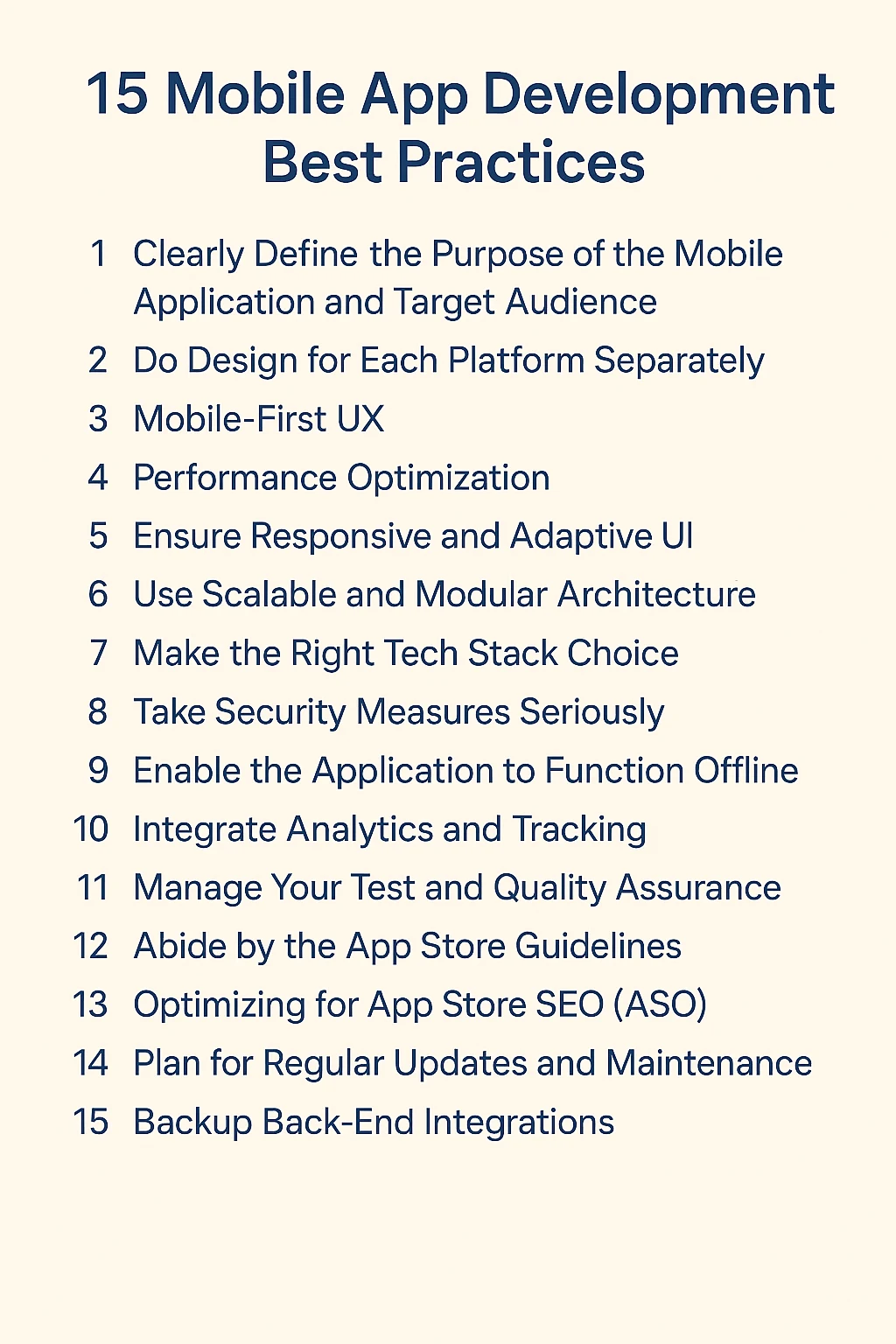1. Introduction
Because we live in a digital-first world, Mobile apps have become essential for growth, customer engagement, and staying competitive. However, creating a mobile app is not just about coding; it involves app development company strategy, planning, user experience, security, and significant ongoing optimization.
Whether you’re a startup or a large enterprise, following mobile app development best practices will guarantee mobile apps will be efficient, high-performing, secure and provide a great user experience (UX). For companies with Dubai business startups looking to jump into the burgeoning tech landscape, following mobile application security best practices and a slim mobile application development process is critical.
In this guide, we will share 15 best practice guidelines designed to help you create an effective mobile application development lifecycle in 2025. We will cover identifying the planning of your mobile app and design, development, security considerations, launch and post-launch optimization.
2. Clearly Define the Purpose of the Mobile Application and Target Audience
The first step begins with a proper mobile application development lifecycle process that starts with clearly defining your app's purpose and identifying your target audience. Mobile app development dubai market is highly competitive, therefore your app needs to solve pain points - it needs to be useful and address needs mobilizing e-commerce payments, enhancing government services, optimizing business productivity etc.

Market research to examine user demographics (age, income, profession) and user behavior (frequency of use, features preferred, etc.). When developing mobile applications in Dubai, it is important to create user personas to customize functionality based on local preferences. This can look like, for example, Arabic language support, and ways to integrate Islamic financing. Using a user-centric approach to mobile app design, will increase rate of adoption and to be sure that your mobile application is providing true value. Also, tying into Dubai's smart city objectives and requirements may lead to unique privileges in partnering with the government or finding funding opportunities.

Market research to examine user demographics (age, income, profession) and user behavior (frequency of use, features preferred, etc.). When developing mobile applications in Dubai, it is important to create user personas to customize functionality based on local preferences. This can look like, for example, Arabic language support, and ways to integrate Islamic financing. Using a user-centric approach to mobile app design, will increase rate of adoption and to be sure that your mobile application is providing true value. Also, tying into Dubai's smart city objectives and requirements may lead to unique privileges in partnering with the government or finding funding opportunities.
3. Do Design for Each Platform Separately
The first step to ensuring success is adhering to your platforms' requirements. . For an iOS app you will want to follow Apple's Human Interface Guidelines (HIG) which are based on principles of clarity, depth, and minimalism. For Android apps you will want to be sure you have adopted the Material Design 3 principles, using bold colors, intentional animations, and great navigation. Native components, such as SwiftUI for iOS, or Jetpack Compose for Android, will provide optimal performance while maintaining platform specifics.
For tech-savvy users in Dubai, platform-specific design is going to provide the most usability while complying with app store review requirements. Avoiding lawsuits and improving engagement will be tied heavily to users receiving a familiar experience.
4. Mobile-First UX
When we develop an app in Dubai, mobile UI/UX design is a prime consideration when you consider the overwhelming reliance of users on their mobile devices. UI responsiveness for one-handed operation must have primary actions designed for the thumb zone (the bottom 2/3 of the screen) along with the correct minimum tapable area (at least 48x48px).
We must also implement best practices for accessibility including VoiceOver/Talkback, color contrast (minimum of 4.5:1) to ensure great user experience for all, and adjustable fonts to reflect all Dubai's users.
The overall best practices ensure that our mobile application UI is meeting WCAG 2.1 criteria as well as meeting the standards of Dubai's international community that includes users of senior age and visual impairment.
Need help designing for Dubai’s multilingual, mobile-first audience?

5. Performance Optimization
Performance optimization can be non-negotiable! They are used to technology working properly, and they want to deal with apps that offer rapid response. Aim for a load time of less than 2 seconds to avoid losing users.
There are advanced caching strategies and ways to compress images (WebP) that considerably reduce the sizes of payloads. We should also make use of code-splitting and lazy-load techniques, not only to make your largest amount of content available more quickly, but to improve critical load order.
For 5G users in Dubai, consider ways to improve overall network calls by wiping the old setup of HTTP and using HTTP/3 instead, and maybe try to capitalize on CDNs too. You can always do regular audits for performance with products like Firebase Performance Monitoring to ensure that your app operates at peak performance across Dubai's device range.
Also Read: Top 10 mobile app development tools
6. Ensure Responsive and Adaptive UI
In mobile app development Dubai, building a responsive UI is important to accommodate the range of devices in the UAE, from flagship smartphones to foldables and tablets. To design user interfaces that dynamically adjust to various screen sizes and resolutions, use Auto Layout for iOS and ConstraintLayout for Android.
Since consumers in Dubai are so tech-savvy, you should test thoroughly on real devices to identify and refine any UI glitches before you launch. Use dynamic layouts and fragment-based designs for a great user experience across all form factors, from small screens to large-sized tablets.
7.Use Scalable and Modular Architecture
For mobile app development Dubai, using MVVM or Clean Architecture is critical, to build maintainable and scalable applications. Both of these patterns separate business logic from UI layers, making it easier to update features and add new features.
Modular architecture allows Dubai developers to work on independent components simultaneously, which can both help speed up development while producing a cleaner bug-free solution.
This architecture also provides a future-proof way of developing your app as Dubai develops technology and can thereby easily add features related to AI, blockchain, or IoT.
Using the right architecture also creates better app security standards, as you will be reliably isolating sensitive data handler, which is essential for meeting all Dubai related compliance regimes.
8. Make the Right Tech Stack Choice
Selecting the right tech stack is very important in mobile app development Dubai, as you must consider the options of using native or cross-platform Flutter/React Native frameworks.
Native development provides the best performance and full access to hardware, and normally is the best option for graphics-heavy or financial apps where lagging performance is not tolerated in the Dubai ecosystem.
Cross-platform solutions can allow for quicker development times and can make it easier to launch MVP versions for a minimal cost.
know How to choose the best custom software development services
Since Dubai is constantly moving towards enhancing a digital economy, it is important to consider the long-term objectives of a city-wide transformation strategy and the level of user experience that is expected in Dubai.
know How to choose the best custom software development services
Since Dubai is constantly moving towards enhancing a digital economy, it is important to consider the long-term objectives of a city-wide transformation strategy and the level of user experience that is expected in Dubai.
9. Take Security Measures Seriously
When working with Dubai mobile app development, there are numerous security measures you will want to put in place to ensure a reliable product. This is especially true in this region of the world, as there are an increasing set of data protection laws that have been implemented in the UAE (DIFC/ADGM regulations).
Recommended practices include:
● TLS 1.3 encryption for all network communications
● AES-256 encryption for local data
● Biometric authentication for secure access
● Regular penetration testing
● OWASP Mobile Top 10 compliance
● Runtime application self-protection (RASP)
Recommended practices include:
● TLS 1.3 encryption for all network communications
● AES-256 encryption for local data
● Biometric authentication for secure access
● Regular penetration testing
● OWASP Mobile Top 10 compliance
● Runtime application self-protection (RASP)
10. Enable the Application to Function Offline
Offline capabilities are vital for mobile users constantly on the go. Use local databases like SQLite or Realm to store essential data. Preload experiences like receipts, menus, or offline maps.
Implement background sync strategies and conflict resolution to maintain data integrity when users reconnect.
11. Integrate Analytics and Tracking
Analytics are key for optimizing your app post-launch. Use:
● Firebase Analytics for real-time insights
● Mixpanel for user segmentation
● Heatmaps to track behavior
● Conversion funnel tracking
● A/B testing to optimize features
This data enables you to iterate and personalize the user journey effectively
● Firebase Analytics for real-time insights
● Mixpanel for user segmentation
● Heatmaps to track behavior
● Conversion funnel tracking
● A/B testing to optimize features
This data enables you to iterate and personalize the user journey effectively
12. Manage Your Test and Quality Assurance
Automate unit and UI tests using XCTest, JUnit, Appium, or Espresso. Conduct:
● Beta testing via TestFlight or Play Store
● Localization testing (Arabic/English)
● Regression testing after updates
This approach reduces post-launch issues and improves user satisfaction in Dubai’s demanding tech environment.
● Beta testing via TestFlight or Play Store
● Localization testing (Arabic/English)
● Regression testing after updates
This approach reduces post-launch issues and improves user satisfaction in Dubai’s demanding tech environment.
13. Abide by the App Store Guidelines
Always align your app with:
● UAE data privacy laws
● App Store metadata standards
● Transparent privacy policies
● Local cultural content compliance
Staying ahead of guideline changes ensures smoother approvals and better app visibility.
● UAE data privacy laws
● App Store metadata standards
● Transparent privacy policies
● Local cultural content compliance
Staying ahead of guideline changes ensures smoother approvals and better app visibility.
14. Optimizing for App Store SEO (ASO)
Improve visibility with:
● Keyword-rich app titles and descriptions
● Bilingual (Arabic/English) screenshots
● A standout app icon
● Leveraging the reviews and ratings system
App store optimization increases your chances of standing out in Dubai’s crowded app landscape.
● Keyword-rich app titles and descriptions
● Bilingual (Arabic/English) screenshots
● A standout app icon
● Leveraging the reviews and ratings system
App store optimization increases your chances of standing out in Dubai’s crowded app landscape.
15. Plan for Regular Updates and Maintenance
Consistency is key. Schedule:
● Monthly updates for bug fixes and patches
● Quarterly updates for new features
● Phased rollouts for testing major changes
This shows your commitment to quality and responsiveness to user feedback.
● Monthly updates for bug fixes and patches
● Quarterly updates for new features
● Phased rollouts for testing major changes
This shows your commitment to quality and responsiveness to user feedback.
16. Backup Back-End Integrations
Ensure:
- Uptime-tested APIs
- Failover mechanisms
- Blockchain Development
- Caching and WebSockets for real-time apps
- Ensure third-party APIs support Arabic
- Compliance with UAE data laws
We help you not just build, but continuously improve your app using real-time analytics.
Connect with Us→
17. Conclusion
Developing a successful mobile app in 2025 requires advanced planning, specialized skill and ongoing enhancements. By following these 15 mobile app development best practices, your mobile application will be distinctive in Dubai, as it will be:
✅ User-friendly – With an intuitive UI/UX design suitable for Dubai's multicultural audiences
✅ High-performing – Designed to be as fast as possible while fully utilizing the 5G technology in the UAE
✅ Secure – To meet UAE compliance for data privacy and using enterprise-grade encryption
✅ Scalable – Built with architecture suitable for future scalability
🔹 Custom native and cross-platform development
🔹 Complete development lifecycle from concept to delivery
🔹 Ongoing support and optimization
🔹 UAE regulations
✅ User-friendly – With an intuitive UI/UX design suitable for Dubai's multicultural audiences
✅ High-performing – Designed to be as fast as possible while fully utilizing the 5G technology in the UAE
✅ Secure – To meet UAE compliance for data privacy and using enterprise-grade encryption
✅ Scalable – Built with architecture suitable for future scalability
🔹 Custom native and cross-platform development
🔹 Complete development lifecycle from concept to delivery
🔹 Ongoing support and optimization
🔹 UAE regulations

The Author
Ramkumar Pichandi
Founder,Rytsense Technolgies
I’m a founder who builds for one reason → To solve real bottlenecks with real technology.
